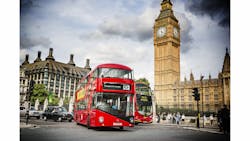When Boris Johnson became mayor or London in 2008, he came to office with three promises: to get ride of the police commissioner, get rid of the articulated buses and bring back the old Routemaster double deck buses.
An avid cyclist, Johnson considered the articulated buses to be the scourge of London responsible for the deaths of many using a bicycle to commute around town. However, bring back a 60-year-old bus concept wasn’t exactly something transportation leaders were excited to see.
“The Routemaster, we’re talking 7 ½ tones, 60-odd capacity and 40-odd years old,” said Gary Filbey, engineering director for Transport for London. “Historically, what a fantastic piece of get, but had to be rebuilt every four years.”
The concept hatched plans to bring on a new generation of Routemaster into the United Kingdom’s largest city and in the process, brought on the single largest order of hybrid buses ever placed in the world.
Something old, something new
TfL is one of the largest transport systems in the world, running 24 hours per day 364 days per year, with Christmas Day the only time buses stand idle with the exception of dial-a-ride. About 16 contractors split 700 different bus routes
There are 8,765 vehicles spread across the fleet, with 16 contracted service providers servicing 6.5 million passengers per day from 19,500 bus stops on 700 routes throughout a city even cab drivers describe as “higgledy pigglidy.” Of those vehicles, Filbey said about three-quarters of them are double decked.
The articulated buses were put into service, but after some accidents with pedestrians and bicyclist after being put into service on some poorly chosen routes in London. The plan to bring back the Routemaster pushed forward despite the high cost given how new the articulated buses were. Lilley said some of the articulated buses ended up heading to Matla, some are sitting in a field and some even caught on fire.
The 16 operators are given a set of parameters they must hit, such as no more than 1.2 minutes per next bus. Buses are expected to last 12-14 years, which the operators choose and own.
The UK is environmentally a forward thinking country, so Filbey said TfL has been embracing hybrid technology since its early days along with hydrogen and pure electric buses including those presently being tested by BYD. When it began looking into hybrids, Filbey said 56 units came to the property from various configurations, such as Volvo, Allison AVL and Isam. Some were double deck, but there are a lot of growing pains in the early years. There are currently 875 hybrids in the TfL fleet.
“I think we need to explore everybody’s technology and we don’t want to put ourselves in the position with the operators to say ‘you will buy this,’” Filbey said. “We Would not want to do that and I don’t think that would be right anyways because bear in mind it’s all government grant money going for this, so it’s up to the operators to choose, then they’ll or die by their decision.”
Some old Routemasters are still in service along Heritage Route No. 15 in London and some residents look back on the old buses fondly, so designers and planners had to make sure a new bus didn’t get stuck in the past.
“With the old Routemaster, what a fantastic vehicle, it runs for 40 years,” Filbey said. “Well, it was rebuilt every four years, it had 424 campaign modifications done to it during its early system’s change…I don’t think we’ll ever go down that road with this, but I have no doubt that there will be other manufacturers trying to mirror some of the design concepts and get their product on the market.”
Leaders in London first went to the public when the decision was made to create an updated Routemaster to be introduced into the city. Children and builders like Aston Martin were asked to design this new generation bus, with Thomas Heatherwick, of Heatherwick Studios, designer of the Olympic Cauldron for the 2012 games in London was chosen for the final design.
It was expected in two years’ time the concept would go from a blank piece of paper into service.
“I went for a brief at TfL’s headquarters with the Transportation Commissioner Sir Peter Hendey, and he said ‘if I walk down to the news agents across the street and get a postcard of Big Bend, a black cab and a red Routemaster, In five year’s time, I want to walk down, Big Bend, black cab, your bus,’” said David Barnett, product director for Wright Bus. “That’s your brief. Forget specifications; forget building to a cost, or the environment. All of that’s important, but that’s the vision — this has to be a postcard.”
Filbey said Hendy and TfL Managing Director of Surface Transport Leon Daniels take the Routemaster very seriously.
“They’re both, shall we say, geeky Harry’s about the Routemaster,” he joked.
There are currently 275 new Routemasters produced by Wright Bus in service in London, with an expectation of 600 of them in service by April 2016. Filbey said there are discussions about purchasing another 200 of them and Wright’s contract goes up to 1,000 buses.
All the buses are hybrids equipped with a Siemens Driveline coupled to a 4.5 liter Cummins diesel engine, which meets Euro 5 standards. Testing is in place for engines set to Euro 6 spec to go into service next year as the U.K. has yet to mandate the standard.
Designers also reached out to the disabled and blind community to meet design changes in the new bus then cobbled together a prototype on top of an old Scania chassis for the public to critique. Barnett said big ideas came to play, such as adding a door to the rear to stop people from jumping onto a moving bus, all units are officially cashless with Oyster card readers at all entrances and riders can enter the bus from the rear door in order to avoid a queue caused by tourists asking questions of the operator. It also produced small attentions to detail like pole holders.
“That handpole clamp; no, it’s ugly,” Barnett said pointing at a photo of a standard clamp. “That passenger, day in, day, day out, looking at that handpole clamp. We agreed on this project to throw away the rule books.”
Buses also can operate on non-peak hours with just an operator who monitors entrances via close circuit cameras. Even their position within a fully enclosed operator cabin was repositioned to give them a better view to the side of the bus.
The creation of an iconic new bus was important to London politicos, but there was still a need to make sure the fuel costs didn’t get lost in the mix.
“In the U.K., fuel costs probably wasn’t even the second biggest cost segment, but now it is the second and it’s growing,” Barnett said. “By the end of this year or certainly by the end of the first quarter of next year it’s probably going to be the single biggest item over and above driver wages in terms of cost to the operators.”
Filbey said TfL has its own testing site at its Millbrook site had the Siemens hybrid systems getting 10 miles per gallon on the Routemaster, but even though the testing is mirrored after an actual route, in real life, the buses are getting about 8 Mpg, which is still better than conventional hybrids getting about 6.5 mpg.
Teething issues
Filbey said TfL has been using the lithium ion batteries for six years and there hasn’t been any issues with overheating on hybrid buses. A prototype bus not did catch fire, but it wasn’t in service. The Routemasters are using lithium phosphate batteries, but new ones coming in the near future will use lithium titanium.
“When you’re at the vanguard of technology as we are, battery technology has been an issue for us in the vehicles,” Filbey said. “And for a number of different reasons, some have ended up in diesel-only mode.”
TfL is still working on improving the time in between failures of the units as well.
“Realistically, it’s not ideally where we want it to be as it exceeded by 0.3 percent,” he said. “When we first got them there was a learning curve, so it was quite high at 0.4-0.45 percent. A lot of the vehicles had to be shut down and rebooted, so it was a big learning curve, but now we’re seeing the fleet running comparatively well.”
Thomas Orberger, business manager with Siemens Industry, said the products and components going into hybrid vehicles are not new technology. Generators, motors and inverter drives have been around for decades transportation applications like trains or trolley buses, the challenge lies in integrating the technologies to work together in a hybrid vehicle and to find the right application of the systems in a city to take full advantage of hybrid or all electric technology.
When a hybrid bus is put into service, it can fail to meet expected fuel savings if not on the proper route, Orberger said, on the other hand, the transit agencies have an desire to deploy its most expensive asset on any give route. Given the high cost of a hybrid bus and lower than expected fuel savings, transit agencies are reluctant to put them into service considering the time it takes to recoup costs even with federal subsidies.
“Transit Agencies receive 80 percent funding for a diesel bus and 90 percent funding for a hybrid bus from FTA which looks on the first look very favorable however the total budget for a fleet procurement is fixed. Comparing $400,000 for a regular bus to $600,000 for a hybrid bus and you’re only funding 10 percent more on the initial capital investment, resulting in 25 percent fewer vehicles if the transit agency decides to go hybrid you have to drive a lot of miles to make up that gap in the investment.” According to Orberger, the business case still can be made if the routes are chosen correctly and powertrain performance lives up to its expectations.
Integration of hybrid systems into buses present a lot of challenges given the unique character of all technologies and cities across the globe, Orberger said, environmental requirements, vibrations from roads, potholes, heat, cold, dust, long operations hours and many other aspects can all have an impact on the drive train system and cause failure. The challenge is not necessarily the individual products they have been applied globally in equally severe conditions. A simple mounting questions of a piece of equipment can have significant implications on reliability and life expectation.
“I think there’s an emphasis more and more to get all of the stakeholders engaged even before the purchase agreement is made,” Orberger said. “We need to define the project goal and look at all of the common knowledge in the industry and the specific customers to see how do we mitigate these issues as a transit authority, as an OEM provider, as a powertrain designer and how do create this product to be very dependable and reliable to provide the greatest return on investment.”

Joe Petrie | Associate Editor
I came to Mass Transit in 2013 after spending seven years on the daily newsbeat in southeastern Wisconsin.
Based in Milwaukee, I worked as a daily newspaper reporter with the Waukesha Freeman from 2006-2011, where I covered education, county and state government. I went on to cover courts for Patch.com, where I was the main courts reporter in the Metro Milwaukee cluster of websites.
I’ve won multiple awards during the course of my career and have covered some of the biggest political events in the past decade and have appeared on national programs.
Having covered local government and social issues, I discovered the importance of transit and the impact it can have on communities when implemented, supported and funded.





